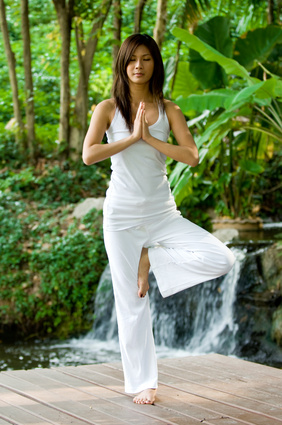Yoga is Good For You
Why should you do yoga? Why not jog, lift weights, do aerobics? Or maybe you get your exercise skiing, snowboarding, or swimming. Of course other forms of exercise work your body in various ways, but yoga is a complete, systematic and time- tested form of exercise that compliments your other activities.
Then again, if you don’t exercise at all, yoga is the perfect way to start. It’s designed for people of all ages and levels of fitness. If it’s your first time, look for a gentle or beginning level class. The beautiful thing about yoga is that it’s not competitive. You work at your own pace, listening to your body, gradually encouraging it to stretch and strengthen – when it’s ready. But don’t think you won’t get a workout! You’ll push your limits but you do it gently and safely, balancing strength with flexibility.
Yoga not only keeps you fit and firm, but provides innumerable benefits to the internal systems of the body as well. The many forward-bending asanas, or positions, stimulate digestion and elimination. Twisting asanas and backbends stimulate spinal nerves, benefiting the entire nervous system. With a healthy nervous system, you are able to relax and face life’s difficulties more steadily. Inversions and other asanas pump up your blood circulation. Breathing exercises bring oxygen to the blood, which then bathes the cells, rejuvenating the body from the inside out. Yoga asanas affect the glands and regulate the production of hormones – in fact, yoga does wonders for all systems of the body.
Even a little effort at this exercise is repaid almost instantly with greatly increased feelings of well-being. With regular practice, you will quickly notice how your body feels lighter, livelier and more limber.
Other, more subtle forms of yoga, such as meditation and Bhakti Yoga practices, are easy to perform, relieve stress and benefit the body, the mind, and you, the Soul.
Japa means "to say softly" and is usually practiced with meditation beads as an aid to focusing the mind and regulating your meditation practice. Meditation or prayer beads are used in many spiritual traditions as a way of "keeping count" without distracting your mind. Interestingly, some researchers say that the rosary reached Europe via the crusaders who were introduced to prayer beads by the Arabs, who first learned about them from the yogis.
You can use special meditation beads called japa mala if you have them, but it's fine to use other beads or a necklace. Japa mala have either 54 or 108 beads, with a head bead at the beginning. They are often made from a sacred wood such as holy tulasi or sandal-wood or from semiprecious stones like jade.
To practice japa, take your set of beads and start with the first bead on the side of the head bead, holding it between the thumb and second finger of your right hand. As you hold this bead, softly say the mantra "Gopala Govinda Rama Madana Mohana." Move your fingers onto the next bead and repeat the mantra again. Continue chanting the mantra on each bead until you come back to the head bead. You have just completed one round of japa. As you softly repeat each mantra, try to keep your mind focused on the sound and gradually you will experience more control of your mind, as well as a welcome sense of inner peace.


|
Yoga is good for you.pdf Size : 65.853 Kb Type : pdf |
Benefits of Balance Poses
Excerpted from an article by Pattie Hughes
 Yoga offers a wide range of health benefits and each type of asana offers slightly different benefits to the mind, body and spirit. Balance poses improve balance, both in the body and in the mind.
Yoga offers a wide range of health benefits and each type of asana offers slightly different benefits to the mind, body and spirit. Balance poses improve balance, both in the body and in the mind.
Balance poses improve coordination, increase strength and develop stability. With regular practice, you will be better coordinated and benefit from improvements in strength and stability during your practice and in your daily life. As people age, improved stability and balance results in fewer injuries that result from falling.
Each balance pose works to strengthen different muscles and joints of the body. Standing balance poses strengthen the legs and knee joints, while arm balances strengthen the wrists, arm and shoulder muscles. For this reason, including a variety of balance poses in your practice is essential to get the full benefits.
Balance poses provide emotional benefits, as well as physical benefits. Balance poses are helpful for relieving stress, reducing tension and fatigue. These asanas also help to improve focus, concentration and memory.
Balance isn't just physical balance, but also emotional and spiritual balance. Life can be hectic and out of control, but relaxation experienced during and after yoga class helps to bring focus and balance to your life off the mat.
The concept of becoming centered is addressed in all forms of yoga and this idea isn't just for yoga class. When you are centered, you are better able to handle the curves and bumps in the road. You are less likely to lose your temper at home, at work or in traffic when you are balanced.